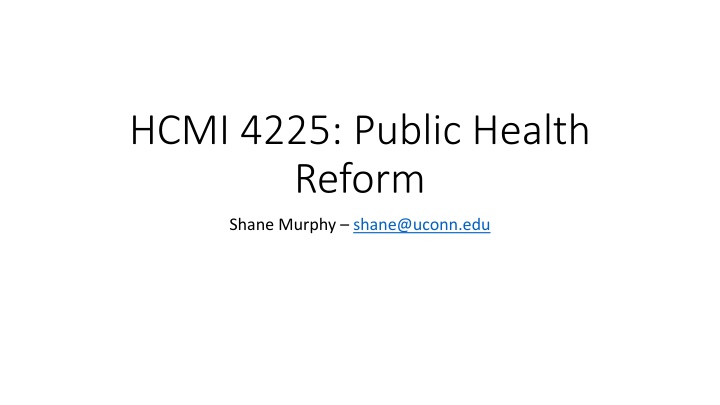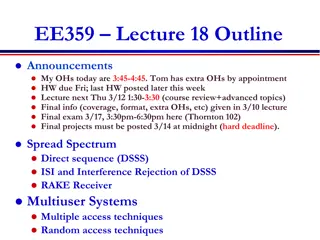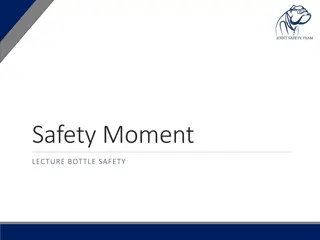
Public Health Reform and Medicaid Expansion Insights
Explore key insights on public health reform, Medicaid expansion, cost challenges, and patient perspectives. Learn about regulatory aspects such as abortion coverage and H.R. 3 Lower Drug Costs Act of 2019. Understand the dynamics between payers, patients, and providers in healthcare reform efforts.
Download Presentation

Please find below an Image/Link to download the presentation.
The content on the website is provided AS IS for your information and personal use only. It may not be sold, licensed, or shared on other websites without obtaining consent from the author. If you encounter any issues during the download, it is possible that the publisher has removed the file from their server.
You are allowed to download the files provided on this website for personal or commercial use, subject to the condition that they are used lawfully. All files are the property of their respective owners.
The content on the website is provided AS IS for your information and personal use only. It may not be sold, licensed, or shared on other websites without obtaining consent from the author.
E N D
Presentation Transcript
HCMI 4225: Public Health Reform Shane Murphy shane@uconn.edu
The problem in two graphs Costs are growing, particularly administrative costs, prices, and overutilization Health isn t improving and for many it is getting worse This may not be the fault of the medical health system, but rather the behavioral health system
Some Polls People like their insurance But not as much as they like their coverage And they don t like the healthcare industry People think the government should play a role But aren t sure what that role should be
Abortion Coverage Regulations Hyde Amendment Applies to subsidies for plans bought on exchange Does not apply to abortions in cases of rape, incest, or endangerment of life of woman States may fund abortion care for Medicaid recipients
H.R. 3, the Lower Drug Costs Now Act of 2019 It will become legal and required for the Centers for Medicare & Medicaid Services to negotiate prices for between 25 and 250 drugs meeting specific criteria and including insulin. The negotiated prices must be offered under Medicare and Medicare Advantage. Private insurers may also be offered the negotiated price. The negotiated maximum price may not be higher than 120% of the average price in specific other industrialized companies. Drug companies failing to comply will face civil and tax penalties. The bill also includes rebates from drug manufacturers to CMS for covered drugs that have prices that rise more rapidly than the increase in inflation and reduces the annual out-of-pocket spending threshold.
3 Ps There are six elements to this model Reform may involve any of these Or more than one at once Payer Patient Provider Reform is a constant, positions shift Red means partisan shifting common Often, these positions are less uniform within a party These are in Brown
Arnold Klings Three Languages of Politics Progressives: The Oppressed vs. Oppression Conservatives: Civilization vs. Barbarism Libertarian: Freedom vs. Coercion I might add the academics/bureaucrats view: The Expert vs. ignorance
Democratic proposals focus on: Coverage for all The ACA cut uninsured rates in half, but no further And purchase of bronze plans and interest in high deductible plans suggests markets are going to lead to less complete coverage Most democratic plans propose a single payer without copayments or deductible available for everyone
Democratic proposals focus on: Costs ACA cost control measures have little or no evidence behind them HMOs create possibly only short term cost improvements Gaming the system has increased Gaming measurement Gaming caase-mix Gaming costs Single payer would shrink administrative costs and reduce corruption/gaming Single payer would negotiate with pharmaceutical companies
Democratic proposals focus on: Payment Less emphasis or detail on payment, similar proposals to Medicare Part A and B Physicians: FFS Hospitals: Capitation Choice Removal of networks used by HMOs/PPOs/POSs
Republican criticisms of Democratic plans Complexity The ACA was 2,300 pages long and now entails 16,000 pages of regulations Cost Government organizations are known for waste Physician incentives Physician pay will have to go down Insuree choice People prefer the public option, so that they could keep their current plan
Republican proposals focus on Liberalize Health Savings Accounts Increase tax deductible contribution maximums Permit broader usage Allow tax-free rollover to survivors
Republican proposals focus on Tax Treatment and Incentives Either remove tax deduction for employer sponsored care or allow deduction for non-employer sponsored care Remove tax deductions for non-high deductible plans Ie treat most plans as Cadillac plans Incentivizing catastrophic plans in combination with HSAs
Republican proposals focus on Reduce regulations on insurance Allow high-deductible plans with fewer coverage mandates Reduce or remove use of employer sponsored health insurance Permit insurers to adjust premiums for obesity and other health risks and pre- existing conditions
Republican proposals focus on Increase Medicare privatization Add private options for Medicare enrollees Include drug benefits in plans Regulate private plans to ensure out-of-pocket limits Combine A, B, and D into one, simplified Medicare public option Promote HSAs for Medicare recipients Increase eligibility age
Republican proposals focus on Increase Medicaid privatization Allow high-deductible private Medicaid plans Seed fund HSAs for Medicaid recipients Use federal funds incentives to push states to encourage enrollees onto high- deductible plans
Republican proposals focus on Reduce regulatory burden Allow nurse practitioners and physician assistants to take a higher role Reduce the power of medical specialty societies restricting supply of doctors Repeal taxes on medical devices and brand-name drugs Reduce bureaucracy in the FDA for device and drug approvals
Democratic criticism of Republican plans Introducing low cost high deductible plans won t lead to universal coverage and will reduce necessary utilization Health Savings Accounts, depending on implementation, will be a regressive tax break Regulations improve care and are necessary Privatizing Medicare and Medicaid is unpopular and may not lead to improvements
Proposals with broad appeal include: Encourage state reinsurance risk pools to expand the size of pools Increase transparency in prices People eligible for no-cost Medicaid or ACA no-cost plans should be automatically enrolled Limited Medicaid expansion To 100% FPL rather than 138% Limit monopoly power, including patent-based monopoly
Narrow reforms Since 1992, broad health care system reform has been on the public s mind Major reforms in that time include: HIPAA (1996) Medicare Part D (2003) ACA (2010) Minor reforms: Hyde Amendment (1997) Tax Cut and Jobs Act (2017) American Recovery Plan (2020)
Tinkering with finance Cost of programs leads to constant tinkering with Who is eligible For what programs Administered and paid for on the state or federal level? National crises often drive changes, with recessions leading to solvency crises and subsequent reforms either on the government revenue side (taxes) or on regulations around receipt of benefits.
Timeline Recessions reduce payroll tax revenue: Nov 1973 Mar 1975 Oil Crisis, Jan 1980 July 1980 double dip, July 1981 Nov 1982 Iran revolution, July 1990 Mar 1991 ending Bush s presidency, Mar 2001 Nov 2001 dot-com bubble, Dec 2007 June 2009 great recession, Feb 2020 June 2020 Covid recession The Tax Equity and Fiscal Responsibility Act of 1982: The prospective payment system required Medicare to pay for most inpatient care using diagnosis-related groups. This significantly reduced federal outlays, quickly leading to an increase in the life span of the trust fund, which remained relatively stable through the end of the 1980s. Balanced Budget Act of 1997: various measures including reductions in the growth of payments to providers, expansion of prospective payments to post acute care facilities, and increased cost sharing for beneficiaries. Reduced revenues from the dot-com bubble triggered the Sustainable Growth Rate (SGR) provisions of the 1997 Balanced Budget Act, requiring a significant cut in Medicare payments. These cuts were canceled by legislation, leading to continued reduction in Trust Fund balance. Expected revenue generators such as the Cadillac Tax, medical device tax, and other parts of the ACA did not end up becoming reality. A year after the ACA went into effect, a fiscal crisis led to the Budget Control Act of 2011, which cut Medicare payments by 2 percent. The Medicare Access and CHIP Reauthorization Act of 2015 permanently repealed the SGR and provided temporary increases in payments for a variety of providers, including ambulance services and home health services in rural areas. The effect has been a depletion of the trust fund at faster than expected rates. Over the past five years, the expected year of exhaustion shortened from 2030 to 2026.
Future Cost cutting legislation Current Law if Fund runs out Payments may be delayed Or reduced New legislation likely Revenue enhancing Cost cutting Radical changes Medicare buy-in with ACA subsidies Push generics Increase payroll tax Policy Option Potential Savings Expand Bundled Payments and Promote New Payment Models $5 to $50 billion Reduce Preventable Readmissions and Unnecessary Complications Up to $10 billion Reduce Payments to Post-Acute Providers $25 to $50 billion Reform and Reduce Payments for Graduate Medical Education $15 to $40 billion Reduce Medicare's Coverage of Bad Debts $15 to $50 billion Expand Medicare and Medicaid Drug Rebates $50 to $150 billion Reduce the Price and Use of High- Cost Drugs Up to $30 billion Adopt Competitive Bidding for Medicare Advantage $25 to $75 billion Limit Medicare Cost-Sharing Rules Up to $20 billion Restrict Supplemental Coverage $50 to $125 billion Limit Medical Malpractice Claims $50 to $70 billion
Discussion I propose that any healthcare system has its faults and can be improved and that good outcomes can be achieved under any system In what ways am I wrong what reforms did you read about could achieve better outcomes than what is currently possible? One issue we discussed is that fractional decision making means no ones ideal system is ever totally implemented. What are some reforms that only make sense if implemented in conjunction with other reforms? What are some reforms that can be implemented in isolation?
Discussion List 3 arguments for universal, single payer health insurance in the US. What are counterarguments for these? List 3 arguments against. What are counterarguments for these? Most arguments revolve around who is helped and who is hurt. In each case, think about who are the stakeholders affected and how they are affected.
Discussion Consider three possibilities, each group will focus on one perspective: 1) Democratic perspective 2) Republican perspective 3) Status quo/centrist Three groups, in your group, consider some of the proposals (5-10) you read about. Who are the stakeholders that advocate for your outcome? Why? Take the position assigned to your group, what would someone advocating for that position say about this proposal? Imaging the country decides to pursue a grand compromise. Would a version of this proposal be something your group would be willing to accept in such a compromise?
Discussion Who are the stakeholders that advocate for your outcome? Why? Low-income families (rural/urban), private insurance companies (large/small), middle/high income families (rural/suburban/urban), employers (large/small) Take the position assigned to your group, what would someone advocating for that position say about this proposal? Imaging the country decides to pursue a grand compromise. Would a version of this proposal be something your group would be willing to accept in such a compromise?
Muhlestein, David. "The Coming Crisis For The Medicare Trust Fund" Health Affairs Blog, December 15, 2020






















